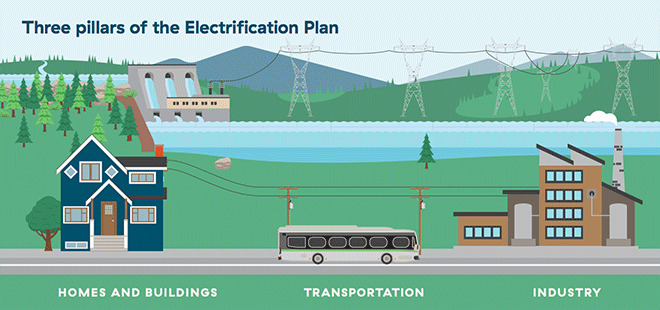What's 'electrification' about, and how will it work?

Heat pump, hot water, and EV rebates key to fuel switching in B.C.
If you're an Alliance member wondering how to convince customers to take advantage of new fuel-switching incentives that are key to our Electrification Plan, you're not alone. And Hansi Liu-Atkinson is here to help.
"I think that 'electrification' in the public sense, and across industry, is seen as this flashy term right now," says Liu-Atkinson, who has the term central to her title as BC Hydro's electrification program manager. "A lot of people are asking, 'how does that even apply to my company, and how do I action that?'"
In essence, it comes down to switching from fossil fuels to clean hydroelectricity to help B.C. meet its greenhouse gas reduction goals. And at least for now, it's all about space heating and cooling, water heating, and electric vehicles.
The challenge is in convincing business and residential customers that the initial capital costs involved in switching to heat pumps and EVs will pay off. It's about making the case, armed with incentives to take some of the sting out of those initial costs, for the long-term benefits of making the switch. And it comes at a time when natural gas prices are relatively low.
We're also investigating ways to reduce supply chain issues that might prevent a customer from quickly getting a heat pump unit to replace their existing gas HVAC system. And as electric vans and other fleet vehicle models start to become available, there are plans for a formal transportation program that goes beyond current rebates for vehicle purchases and charger installations.
This piece is the first in a series about electrification and what it means for Alliance members and their customers. We're starting with the basics of the electrification plan.
Climate change hits B.C. hard, and energy use is key
Greenhouse gas emissions per person in B.C. have been steadily increasing since 2015. As a result of global emissions, the average temperature in all regions of B.C. has risen by 1.2°C, and the effects of extreme weather – from wildfires to droughts and flooding – are shockingly visible.
A key driver of climate change is energy use. Using clean electricity in place of fossil fuels provides us with an opportunity and a solution to reduce our impact on climate change. Here in B.C., we have the advantage of an abundance of clean electricity available.
About 98% of the power BC Hydro generates already comes from clean or renewable resources, mostly from our hydroelectric resources that are powered by water. Yet, despite having access to the cleanest electricity, nearly 70% of the energy used by British Columbians is provided by fossil fuels.
Only 41% of B.C. homes are heated by electricity, and only 33% of home water heating is electric. And the picture is similar for businesses, with 49% of heating and 48% of water heated by electricity.
The near future is electric
The Province's CleanBC Plan provides a road map to get us to this more sustainable future. It was developed as a pathway to achieve the climate targets of reducing greenhouse gas emissions by 40% by the year 2030, based on 2007 levels.
The plan aims to transform the buildings British Columbians work and live in, how they get around, and how to power the economy using cleaner energy. By 2030, the Province's CleanBC Plan aims to:
- Reduce greenhouse gas emissions from transportation by up to 32%
- Reduce GHG emissions from buildings and communities by up to 64%
- Increase the percentage of zero-emission vehicles – cars and trucks – to 30% by 2030 and to 100% by 2040.
Electrification Plan's three pillars: buildings, transportation and industry
Over the next five years, BC Hydro plans to invest over $260 million to advance electrification in B.C. by focusing on three key segments – homes and buildings, transportation and industry – with an expectation of some exciting opportunities to electrify:
- Space and water heating
- Personal, transit and fleet vehicles, along with marine, port, airport and rail vehicles, plus power tie-ins to replace mobile generators
- Industrial processes, natural gas production and pipelines, clean technology and innovation (data centres, hydrogen production, and carbon capture sequestration)
Through our plan, we've set ambitious targets for ourselves. This includes encouraging and incentivizing residents and businesses to switch from fossil fuels to clean electricity – adding 3,100 gigawatt hours of load and reducing greenhouse gas emissions.
Get more details about electrification, including access to the full plan document.